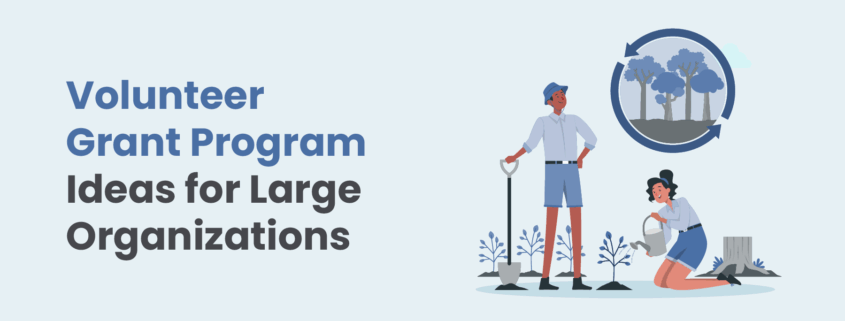Volunteer Grant Program Ideas for Large Organizations
In the realm of corporate philanthropy, volunteer grant programs (often called “Dollars for Doers”) have emerged as an essential tool for nonprofits of all shapes and sizes to enhance their fundraising efforts and engage with supporters. By leveraging volunteer grant programs, large nonprofits, in particular, can tap into a hidden source of funding while also strengthening their community connections and enhancing their impact.
For sizable organizations, these programs represent a tremendous opportunity to amplify their missions. Not only do they offer an additional revenue stream, but they also provide a way to deepen relationships with individual supporters and corporate partners alike and engage supporters in a meaningful way. This article will explore various strategies that large nonprofits can implement to maximize the impact of volunteer grant programs, from building corporate partnerships to optimizing engagement with supporters.
Understanding Volunteer Grant Programs
A volunteer grant program is a corporate initiative in which companies offer monetary donations to nonprofits based on the volunteer hours their employees contribute. The idea behind these programs is simple: the more hours an employee volunteers, the more funding a nonprofit can receive from the company. In many cases, companies establish a tiered system where the donation amount increases with the number of hours volunteered, creating a strong incentive for individuals to contribute more time to nonprofit causes.
For large nonprofits, these programs represent a valuable opportunity to generate additional resources without requiring significant fundraising efforts. The key to success lies in effectively promoting the program to your supporters, tracking volunteer hours accurately, and establishing strategic partnerships with companies that have active volunteer grant programs.
Why Volunteer Grant Programs Matter for Large Nonprofits
Volunteer grant programs can offer large nonprofits many advantages, especially when implemented strategically. These programs not only provide nonprofits with additional financial resources, but they also offer a way to engage supporters and strengthen corporate partnerships.
Here are some of the most significant benefits:
1. Increased Financial Support: One of the most immediate and tangible benefits of volunteer grant programs is the additional funding that nonprofits can secure. When supporters volunteer with companies that match their hours with grants, nonprofits can receive sizable financial contributions without having to organize additional fundraising events. This is especially important for large nonprofits that have broad support bases and rely on sustained funding to continue their work.
2. Strengthened Corporate Partnerships: Volunteer grant programs can help forge deeper relationships between nonprofits and corporate partners. Large nonprofits that engage with companies offering these programs often find that they not only receive financial support but also establish long-term partnerships. These partnerships can lead to further collaboration, including employee volunteer days, cause marketing initiatives, and other forms of corporate giving.
3. Increased Visibility and Supporter Engagement: For large nonprofits, volunteer grant programs are a great way to engage a wide variety of supporters, from individuals to larger community groups. Many nonprofits rely on volunteers to help with events, outreach, and program delivery, and volunteer grants offer an additional incentive for supporters to contribute their time. Moreover, by encouraging supporters to volunteer through these programs, nonprofits can cultivate a more committed and engaged donor base that is more likely to continue supporting the organization in the long term.
4. Boosted Brand Recognition and Awareness: When a nonprofit is involved in a volunteer grant program, it often leads to greater recognition. Many companies actively promote their volunteer efforts, which can raise awareness of the nonprofit’s mission. This increased visibility can lead to new supporters, additional donations, and stronger relationships with both individual and corporate donors.
Key Components of a Successful Volunteer Grant Program
To maximize the impact of volunteer grant programs, large nonprofits must be strategic in how they set up and manage these initiatives. Below are some essential elements to consider when developing or enhancing a volunteer grant program:
-
Identifying Eligible Nonprofits
The first step in taking advantage of volunteer grant programs is identifying which nonprofits are eligible for these grants. For large nonprofits, it’s important to ensure that the corporations you work with have a structured program in place that includes clear eligibility criteria. Many companies limit their volunteer grants to nonprofits that align with their mission or are registered as 501(c)(3) organizations. Therefore, understanding the eligibility requirements for each potential corporate partner is critical to making the most of these opportunities. -
Building Corporate Partnerships
The strength of a volunteer grant program depends heavily on the partnerships you form with corporations. To maximize participation, large nonprofits should establish relationships with companies that have active volunteer grant programs and whose missions align with their own. For example, a nonprofit focused on environmental sustainability might partner with companies in the renewable energy sector or with those who actively promote sustainability. Reaching out to these companies can help create a pipeline for volunteer grant opportunities, ensuring that your nonprofit can benefit from every volunteer hour contributed by employees of these companies. -
Promoting Volunteer Opportunities
Effective promotion of volunteer grant programs is crucial to engage your supporters. Large nonprofits can leverage multiple communication channels to encourage supporters to participate. Consider using email campaigns, social media, newsletters, and your website to promote volunteer opportunities and remind your supporters about the possibility of securing a grant for your nonprofit through their volunteer efforts. Creating a dedicated section on your website where supporters can easily access information about corporate volunteer grants and how they can get involved is a practical approach to ensuring maximum participation. -
Providing Support and Clear Instructions to Volunteers
In order for supporters to take full advantage of volunteer grant programs, nonprofits must provide clear instructions on how to participate. This includes informing them about the process of logging their volunteer hours, the minimum number of hours required for grant eligibility, and the specific steps they need to take to apply for a grant. To make it easy for supporters, nonprofits can create step-by-step guides, FAQs, and video tutorials on how the process works. By making the process as simple and transparent as possible, nonprofits can increase the likelihood of supporters participating and successfully securing funding for the cause. -
Tracking and Reporting Volunteer Hours
A critical element of volunteer grant programs is the tracking of volunteer hours. Many companies require nonprofits to submit reports of volunteer hours in order to qualify for grant disbursement. Large nonprofits should invest in volunteer management software or platforms that can help track volunteer hours efficiently. These systems should allow supporters to log their volunteer time, which can then be verified and reported to the company offering the grant. In addition to simplifying administrative work, these platforms can also provide real-time updates, making it easier for both nonprofits and volunteers to stay on top of their participation.
To further enhance the success of your volunteer grant program, large nonprofits must also prioritize building trust and transparency throughout the process. By fostering a clear, consistent line of communication with both volunteers and corporate partners, organizations can strengthen their relationships and ensure the program runs smoothly.
Optimizing Volunteer Grants for Your Large Nonprofit
Large nonprofits should regularly evaluate and optimize their volunteer grant programs to ensure they are as effective as possible. Here are some strategies for optimizing the program:
-
Analyze Data to Measure Success
Using data analytics to track KPIs such as the number of volunteer hours logged, the total grants received, and the types of activities that generate the most volunteer hours is essential for assessing the effectiveness of the program. Regular analysis helps you identify trends, spot areas for improvement, and optimize engagement strategies for future efforts. -
Solicit Feedback from Supporters
Feedback from supporters is vital in refining the volunteer grant program. Regularly asking volunteers for their input on the process, whether through surveys or informal discussions, can provide valuable insights into how you can make the program more user-friendly and engaging. -
Expand Partnerships and Reach
For large nonprofits, the potential for growth lies in the expansion of partnerships with corporations that offer volunteer grants. Look for new ways to expand your outreach to potential corporate partners by attending corporate networking events, hosting informational sessions, or even collaborating with other nonprofits to pool resources. - Leverage Team Volunteer Opportunities
Large organizations likely have the capacity to organize team volunteer events. Luckily, group volunteer events allow your organization to qualify for team-based grants, which often have higher funding thresholds. For example, Verizon offers a $750 grant for teams of five or more employees who volunteer together.
To further optimize your volunteer grant program, it’s essential to continuously engage with both your volunteers and corporate partners to ensure the program remains dynamic and responsive. This approach, which emphasizes transparency, recognition, and continuous communication, ensures that your volunteer grant program thrives and evolves to meet the needs of both your supporters and your nonprofit’s objectives.
Final Thoughts
Volunteer grant programs represent a significant opportunity for large organizations to enhance their community impact while fostering employee engagement. By implementing effective strategies and continuously optimizing the program, organizations can create a sustainable model that benefits both employees and the nonprofits they support.
Maximize Your Volunteer Grant Potential with Double the Donation
Want to see how your volunteer grant efforts could translate into measurable revenue growth? With Double the Donation Volunteering, you can increase volunteer participation, guide supporters through volunteer grant submissions, and establish deeper corporate partnerships all in one place, making it easier to uncover hidden opportunities and showcase your program’s impact.
Discover how the right tools can turn volunteer hours into sustainable funding for your mission. Get a demo today!



